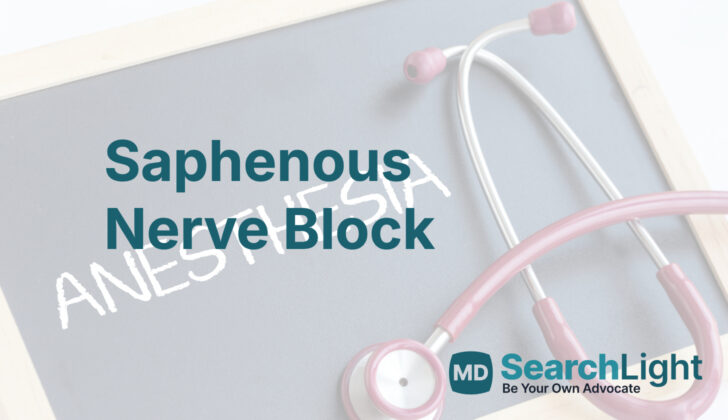Overview of Saphenous Nerve Block
The saphenous nerve block is a technique often used in emergencies and before or after surgeries for numbing and managing pain. It’s a type of regional anesthesia that is usually applied to help with pain on the inside of the leg and ankle. It can be carried out under ultrasound guidance for accuracy.
Anatomy and Physiology of Saphenous Nerve Block
The saphenous nerve is a part of the body that starts from the area around our lower back (L3-L4 nerve roots) and is an offshoot of the femoral nerve, which is located in the thigh. Its job is mainly to pass on sensations from a specific part of the leg and foot to the brain. This nerve covers the inner and lower part of the leg, ankle, and foot. The nerve separates from the femoral nerve in the upper portion of the thigh. It then travels downward, positioned just to the right of a pouch-like structure in the thigh called the femoral sheath, residing in a channel called the adductor canal. It then crosses over, moving from the back to the front of the femoral artery.
Once the saphenous nerve exits the adductor canal, it makes a hole in the fascia lata, a layer of fibrous tissue in the thigh. It’s located between the tendons of the gracilis and sartorius muscles, which are parts of the leg that help in its movement. At this point, it usually splits into two parts – the infrapatellar branch and the sartorial branch. It then branches out into several smaller nerves. As it travels or descends downwards on the inner side of the lower leg, it goes by the great saphenous vein. Along its path, it releases multiple small branches that send sensation signals from the inner part of the lower leg, ankle, and front part of the foot to the brain.
Why do People Need Saphenous Nerve Block
A saphenous nerve block is a type of local anesthetic used when there is a need to numb the lower leg or foot. It’s often used together with a type of anesthetic called a popliteal sciatic nerve block, to provide complete numbness of the lower leg. This can be helpful for various medical procedures, including removal or repair of varicose veins (known as saphenous vein stripping or harvesting), wound repair or examination, resetting a broken ankle or a dislocated joint, draining an abscess, and removing foreign bodies.
When a Person Should Avoid Saphenous Nerve Block
There are a few reasons why a doctor might not be able to perform a saphenous nerve block, which is a procedure used to numb a part of the body. These include:
1. If a person is allergic to the medicines or other substances that are used during the procedure.
2. If there’s an infection at the spot where the doctor injects the numbing medicine.
3. If a person doesn’t want to have the procedure done.
These are considered absolute reasons, which means under these conditions the procedure should not be performed. But there are also some relative reasons that might make it less safe or effective. These include if:
1. A person has a condition that makes it hard for their blood to clot, known as coagulopathy. This could increase the risk of bleeding.
2. A person has an infection somewhere else in their body, not just at the site of the injection.
3. A person already has nerve issues in the area where the block would be applied. This could possibly complicate the effects of the procedure.
Equipment used for Saphenous Nerve Block
The following items are needed to perform this procedure:
* A disinfectant liquid (povidone iodine or chlorhexidine gluconate), which is used to clean the skin and prevent infections.
* Sterile gloves to maintain cleanliness during the operation.
* A sterile drape, which is a sheet used to cover the patient and keep the procedure area clean.
* A face mask with an eye shield for protecting the healthcare professional against possible splashes during the operation.
* A linear ultrasound device (8-14 MHz) with a sterile cover and gel. This device helps the doctor see the inside of the body to guide the procedure.
* A local anesthetic like lidocaine 1% is used to numb the skin surface and prevent pain during the procedure.
* A regional block local anesthetic such as bupivacaine 0.5% or ropivacaine 0.5% is used to numb a larger area and control pain for a longer period after the procedure.
* A 10 mL syringe to inject the local anesthetics.
* A 50-mm, 22-gauge short-bevel block needle to inject the anesthetics. This needle has a small, sharp tip that makes the injection less painful.
Who is needed to perform Saphenous Nerve Block?
A medical expert who has specific training in using ultrasound for regional anesthesia should carry out the procedure. In simpler terms, this means that a specialist who knows how to use ultrasound imagery to accurately deliver medicine that numbs a specific area of your body should be the one to do this. The medicine numbs or “blocks” pain from that area during treatment or a procedure.
Preparing for Saphenous Nerve Block
Before the procedure, the doctor will explain everything to the patient and get their approval to move forward with the treatment. This is known as informed consent, and it’s a standard process in hospitals. The doctor will also examine the patient’s nervous system and muscles to ensure they are healthy enough for the procedure.
How is Saphenous Nerve Block performed
The saphenous nerve block is a medical procedure used to numb specific areas of the leg. This procedure can be performed in two main parts of the leg: the middle of the thigh (in an area known as the adductor canal), or just below the knee. The choice of location depends on which area of the leg needs to be numbed. Although doctors can find these locations just by looking and touching, they usually use ultrasound (a tool that uses sound waves to create pictures of the inside of the body) to get a clear view of where they should do the procedure.
The first approach, known as the adductor canal approach, numbs the middle of the thigh. If you’re having this procedure, you’ll be asked to lie on your back and turn your leg out to the side. This action gives the doctor easy access to the inner part of your thigh. Once you’re in position, the area will be cleaned to reduce the risk of infection. Then, an ultrasound machine will be used to guide the doctor. They will find the right spot for the nerve block by moving the ultrasound probe up your leg until a thick band (called the vastoadductor membrane) is no longer clearly visible and your femoral artery (a major blood vessel) can be seen. The saphenous nerve is usually found next to this artery. After making sure the needle isn’t in a blood vessel (by pulling back on the syringe to see if any blood is drawn up), the doctor will inject some numbing medicine next to the nerve.
The saphenous nerve can also be numbed below the knee to numb the lower leg and foot. In this situation, you will also lie down on your back with your leg straight. The area will be cleaned and sterilized, then the doctor will use an ultrasound machine to locate the saphenous vein and a layer of tissue known as the fascia lata. The numbing medicine will be injected in the space between these two structures.
Sometimes, it’s necessary to numb the saphenous nerve at the ankle, although it’s challenging to see the nerve with an ultrasound at this level. In this case, a technique that relies on known landmarks on the body is more reliable. However, this might require more numbing medicine. You can identify these landmarks by feeling for specific structures in your ankle, like the medial malleolus (the bony bump on the inside of your ankle) and the great saphenous vein. After finding these landmarks, the numbing medicine is injected around the saphenous vein, close to the medial malleolus. If the saphenous vein can’t be felt or seen, an ultrasound machine can help guide the procedure.
Don’t hesitate to ask your doctor to explain what they are doing and why. They will be glad to help you understand your treatment better.
Possible Complications of Saphenous Nerve Block
There can be some risks associated with a saphenous nerve block, a type of local anesthesia injected near your inner thigh to control pain. Some people might experience pain where the injection is given, or an infection could develop at that site. Other possible complications are bleeding, nerve damage, allergic reactions, and in rare cases, local anesthetic systemic toxicity, which is a severe reaction to the anesthesia throughout your whole body.
There’s a bit of a debate about whether or not a procedure called an adductor canal block might cause weakness in the quadriceps muscles, particularly a muscle called the vastus medialis, as a side effect. This procedure involves numbing nerves in your thigh with anesthesia to relieve pain. However, many studies have found that this procedure doesn’t cause significant muscle weakness, especially when compared to a similar procedure called the femoral nerve block.
Using ultrasound during these procedures can help doctors see exactly where they’re placing the anesthesia, which can reduce the chances of nerve injury, accidental puncture of blood vessels, or local toxicity, which is harmful effects in the area where the anesthesia was given.
If someone does experience a serious reaction to the anesthesia, it’s important to treat this quickly to prevent long-term health problems. One treatment is giving intravenous lipid emulsion therapy, or a type of fat particles directly into the bloodstream. The usual dose is a quick injection of a 20% lipid emulsion, followed by a slower infusion. Doctors may also reach out to a poison control center for advice on how to manage this situation.
What Else Should I Know About Saphenous Nerve Block?
The saphenous nerve is a nerve in your leg that helps you sense things on the front and inner part of your lower leg. If we need to numb this part of your leg, we can block this nerve. This process is particularly safe and reliable when we use ultrasound to guide us as it helps us see exactly where to apply the block.
Using this nerve block, we can avoid putting your entire body to sleep and reduce the need for strong painkillers like opioids. This is beneficial because it lowers the risk of side effects from having your entire body under anesthesia or from taking strong pain medications.












